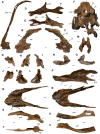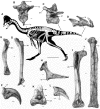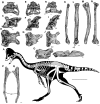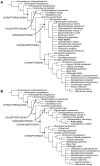A new large-bodied oviraptorosaurian theropod dinosaur from the latest Cretaceous of western North America
- PMID: 24647078
- PMCID: PMC3960162
- DOI: 10.1371/journal.pone.0092022
A new large-bodied oviraptorosaurian theropod dinosaur from the latest Cretaceous of western North America
Erratum in
-
Correction: A new large-bodied oviraptorosaurian theropod dinosaur from the latest Cretaceous of western North America.PLoS One. 2015 Apr 29;10(4):e0125843. doi: 10.1371/journal.pone.0125843. eCollection 2015. PLoS One. 2015. PMID: 25923787 Free PMC article. No abstract available.
Abstract
The oviraptorosaurian theropod dinosaur clade Caenagnathidae has long been enigmatic due to the incomplete nature of nearly all described fossils. Here we describe Anzu wyliei gen. et sp. nov., a new taxon of large-bodied caenagnathid based primarily on three well-preserved partial skeletons. The specimens were recovered from the uppermost Cretaceous (upper Maastrichtian) Hell Creek Formation of North and South Dakota, and are therefore among the stratigraphically youngest known oviraptorosaurian remains. Collectively, the fossils include elements from most regions of the skeleton, providing a wealth of information on the osteology and evolutionary relationships of Caenagnathidae. Phylogenetic analysis reaffirms caenagnathid monophyly, and indicates that Anzu is most closely related to Caenagnathus collinsi, a taxon that is definitively known only from a mandible from the Campanian Dinosaur Park Formation of Alberta. The problematic oviraptorosaurs Microvenator and Gigantoraptor are recovered as basal caenagnathids, as has previously been suggested. Anzu and other caenagnathids may have favored well-watered floodplain settings over channel margins, and were probably ecological generalists that fed upon vegetation, small animals, and perhaps eggs.
Conflict of interest statement
Figures







Similar articles
-
A new oviraptorosaur (Dinosauria: Theropoda) from the end-Maastrichtian Hell Creek Formation of North America.PLoS One. 2024 Jan 24;19(1):e0294901. doi: 10.1371/journal.pone.0294901. eCollection 2024. PLoS One. 2024. PMID: 38266012 Free PMC article.
-
A new troodontid theropod, Talos sampsoni gen. et sp. nov., from the Upper Cretaceous Western Interior Basin of North America.PLoS One. 2011;6(9):e24487. doi: 10.1371/journal.pone.0024487. Epub 2011 Sep 19. PLoS One. 2011. PMID: 21949721 Free PMC article.
-
Functional anatomy of a giant toothless mandible from a bird-like dinosaur: Gigantoraptor and the evolution of the oviraptorosaurian jaw.Sci Rep. 2017 Nov 24;7(1):16247. doi: 10.1038/s41598-017-15709-7. Sci Rep. 2017. PMID: 29176627 Free PMC article.
-
Osteology and relationships of Revueltosaurus callenderi (Archosauria: Suchia) from the Upper Triassic (Norian) Chinle Formation of Petrified Forest National Park, Arizona, United States.Anat Rec (Hoboken). 2022 Oct;305(10):2353-2414. doi: 10.1002/ar.24757. Epub 2021 Sep 29. Anat Rec (Hoboken). 2022. PMID: 34585850 Free PMC article. Review.
-
A large non-marine turtle from the Upper Cretaceous of Alabama and a review of North American "Macrobaenids".Anat Rec (Hoboken). 2023 Jun;306(6):1411-1430. doi: 10.1002/ar.25054. Epub 2022 Aug 19. Anat Rec (Hoboken). 2023. PMID: 37158131 Review.
Cited by
-
Cranial functional specialisation for strength precedes morphological evolution in Oviraptorosauria.Commun Biol. 2024 Apr 10;7(1):436. doi: 10.1038/s42003-024-06137-1. Commun Biol. 2024. PMID: 38600295 Free PMC article.
-
Transformation of the pectoral girdle in pennaraptorans: critical steps in the formation of the modern avian shoulder joint.PeerJ. 2024 Feb 29;12:e16960. doi: 10.7717/peerj.16960. eCollection 2024. PeerJ. 2024. PMID: 38436017 Free PMC article.
-
A new oviraptorosaur (Dinosauria: Theropoda) from the end-Maastrichtian Hell Creek Formation of North America.PLoS One. 2024 Jan 24;19(1):e0294901. doi: 10.1371/journal.pone.0294901. eCollection 2024. PLoS One. 2024. PMID: 38266012 Free PMC article.
-
Large-bodied ornithomimosaurs inhabited Appalachia during the Late Cretaceous of North America.PLoS One. 2022 Oct 19;17(10):e0266648. doi: 10.1371/journal.pone.0266648. eCollection 2022. PLoS One. 2022. PMID: 36260601 Free PMC article.
-
Digital restoration of the pectoral girdles of two Early Cretaceous birds and implications for early-flight evolution.Elife. 2022 Mar 31;11:e76086. doi: 10.7554/eLife.76086. Elife. 2022. PMID: 35356889 Free PMC article.
References
-
- Osmólska H, Currie PJ, Barsbold R (2004) Oviraptorosauria. In: Weishampel DB, Dodson P, Osmólska H, editors. The Dinosauria, Second Edition. Berkeley: University of California Press. pp. 165–183.
-
- Ji Q, Currie PJ, Norell MA, Ji S-A (1998) Two feathered dinosaurs from northeastern China. Nature 393: 753–761.
-
- Lü J, Currie PJ, Xu L, Zhang X, Pu H, et al. (2013) Chicken-sized oviraptorid dinosaurs from central China and their ontogenetic implications. Naturwissenschaften 100: 165–175. - PubMed
-
- Xu X, Tan Q, Wang J, Zhao X, Tan L (2007) A gigantic bird-like dinosaur from the Late Cretaceous of China. Nature 447: 844–847. - PubMed
-
- Xu X, Cheng Y-N, Wang X-L, Chang C-H (2002) An unusual oviraptorosaurian dinosaur from China. Nature 419: 291–293. - PubMed
Publication types
MeSH terms
Grants and funding
LinkOut - more resources
Full Text Sources
Other Literature Sources


